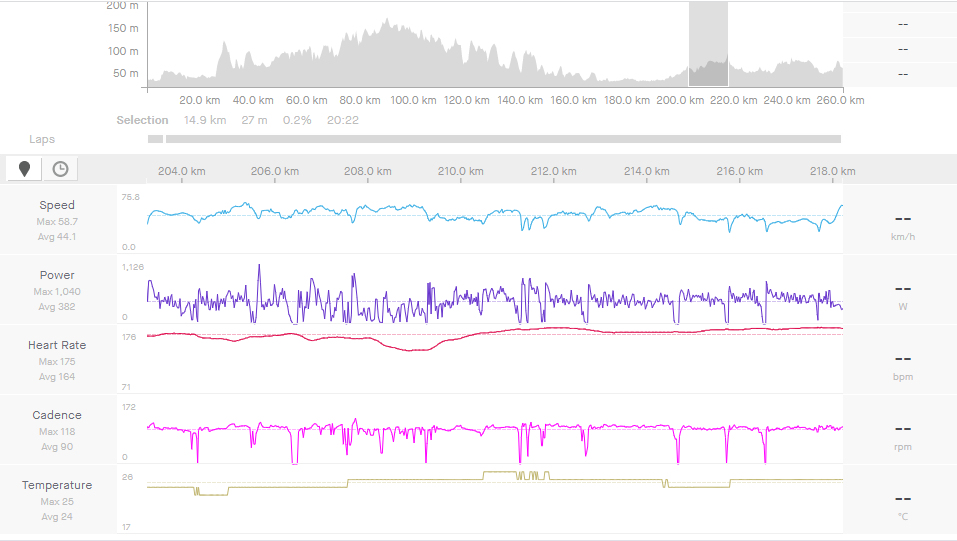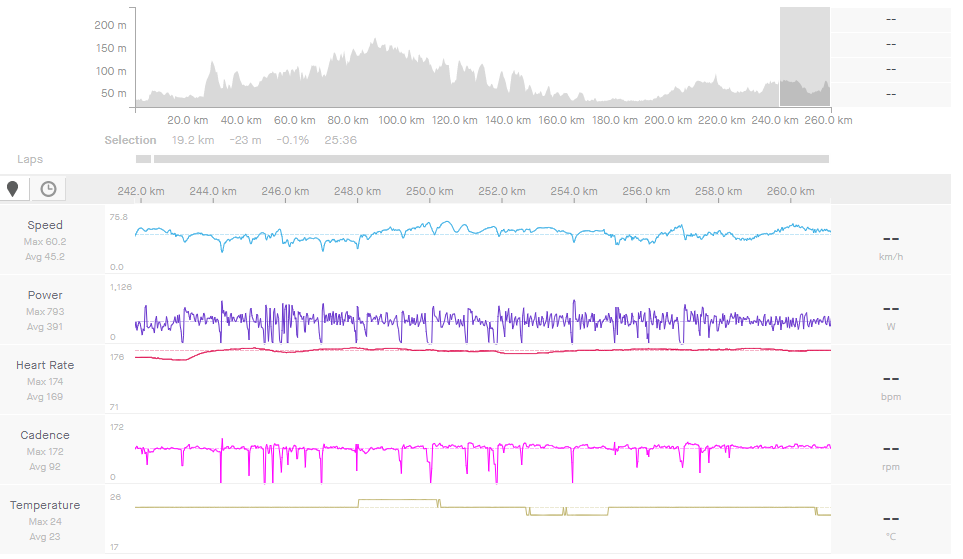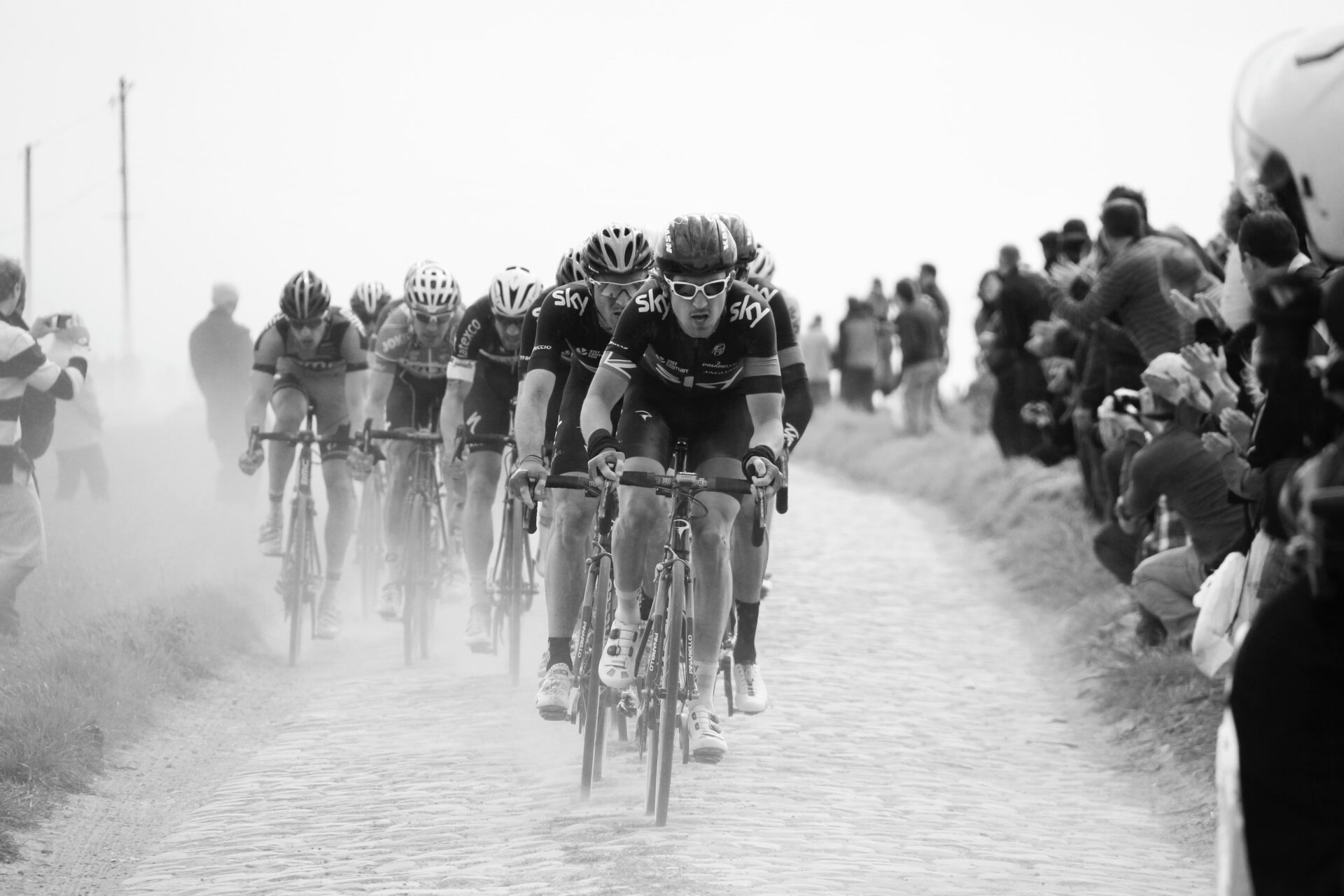Dylan Van Baarle’s triumphal ride is definitely one for the history books. And with his power data available it’s also one we can learn from.
I like to dive deep into the data and see what we can get out of it for ourselves. And honestly, what better race file to analyze than the one from the winner of the fastest-ever Paris-Roubaix edition? With race tactics and tension, the queen of the spring classics didn’t disappoint. Van Baarle put on a great show!
Paris-Roubaix is a lot about zone 2 and zone 3 training. About who can ride in the tempo zone for hours on end and is great at surging out of it.
1. Van Baarles Power Data and Physiology
Let’s first look at van Baarle’s data and what his physiology looks like:
- Race time: 5h 52min 31sec
- Distance: 262.8 km
- Avg speed: 44.8 km/h
- Avg power: 310 w
- Normalized Power (NP): 353 w
- Energy: 6.518 kJ
- Max avg power for 20min: 396 w
- Max power: 1126 w
- Intensity Factor (IF): 0.802
- Kjs per hour: 1.101 kj
- FTP: 440 w
- Weight: 78 kg
- Power to weight ratio at ftp: 5.64 w/kg
A first look confirms – it’s a tremendous effort. Producing over 1.100kj per hour for 6 hours straight is insane. The good thing is that we have his NP and the IF. Therefore, we can extrapolate his FTP.
If we look at the NP for his ride is in the range of a 6h tempo-ish ride as it’s around 80% of FTP. Imagine doing a tempo ride for almost 6 hours straight.
Anyways, when we look at the avg. power of his race it’s around 70% of FTP. This is likely around VT1 (there are variations for sure). In a 3-zone model, it’s the two thresholds, the aerobic and anaerobic dividing the zones.
1.1 Decisive Race Attacks
Van Baarle went for two very hard efforts that ultimately determined the race.
Attack 1 happened with about 50 km to go. He attacked out of the van Aert group with a max power of 1040 w. This was after more than 4.5 hours of hard racing already. It took him like 18-20 min to reach the trio and an average. power of 382 w. His max heart rate was 175 bpm and avg. at 164 bpm. Cadence at around 90 rpm. So, what we can see here is a very hard tempo attack with lots of spikes late in the race:

The second attack appeared with 18km to go. On the cobbles, he pushed a max power of 793 w to go clear of the rest. And what’s interesting here: This attack also forms his highest avg. power for 20 min. He soloed for over 20 minutes at 396 watts after 5.5 hours of cobbles, dirt, and pain! While cadence is still smooth with an avg. of 92 rpm.
Here again is a very hard zone 3 effort to decide the race. For ultra-endurance bike races this transfers into being able to push tempo for a very long time. And more so, you need to be able to attack out of zone 3 zone and go back to it to clear lactate, while still pushing hard.
Now, how can we put the given data into practice to improve and train for events specifically?

2. Doing Proper Zone 3 Training
If you want to build a lasting training plan there’s 1 mistake you should avoid: Riding way too often at higher intensities. Or to make it clear. Easy zone 2 riding should make up the bulk of your training. And I mean a lot. At least 75-80% of overall training time. It’s all about endurance.
Because there are a bunch of studies that researched training intensity distribution and all came to the same conclusion: Easy endurance training is the most important part. That’s because once we pass our aerobic threshold we accumulate autonomic stress and burn lots of carbs. And our bodies can handle only a certain amount.
This translates into sticking to two high-quality interval sessions per week. So, zone 3 tempo is no gray zone at all. It’s just about the right amount and the right sessions. The dose makes the poison. That’s why I call it the gray zone fallacy. Zone 3 training isn’t the enemy, it’s a lack of zone 2 training. Because tempo sessions themselves are highly beneficial.
For that reason, you should do zone 3 or zone 4 training as interval sessions. Dedicate a predetermined time to it. Recover. Go for the next set.
A typical session could look like a 2h endurance ride with 4x20min at tempo around 80-90% of FTP. You can either decrease the amount or increase it up to like 3x30min tempo. But always make sure to consume enough carbs before and during the ride. I wrote an article about the new gold standard of carb intake. Just click here.
3. The Benefits of Zone 3 Efforts
There are many benefits of doing proper tempo training. At first, you can quickly accumulate lots of kilojoules to replicate energy usage for racing without the crazy fatigue from high-intensity sessions.
And as we’ve seen from van Baarle’s file zone 3 is where you end up racing. Furthermore, you will maximize muscular endurance and mimic racing demands as you do sets of tempo at the end of a ride while being pre-fatigued. Moreover, tempo intervals will increase your mitochondrial density and result in a very rich reproducibility of power. Hence, you’ll be able to attack again and again.
If you want to see more data about the demands of ultra-endurance racing I highly recommend checking out the Training Peaks series about the pro career training of former Paris-Roubaix Champion Mathew Hayman here and here.
4. Conclusion
There are some important takeaways from van Baarle’s race, let’s summarize:
- endurance training like zone 2 is fundamental: make it the biggest part
- train specific to the demand of the race
- zone 3 training is no gray zone, just use it right
- do zone 3 sessions as interval training
- threshold training is important too for lactate tolerance
- ultra-endurance racing is all about fatigue resistance
Pro riders show unbelievable performances. But there’s a lot we can transfer from it. As cycling is a tough sport, building resilience is what we should focus on. And getting your zone 3 workouts done will prepare you for the challenge of bike racing.
Ready to Improve Your Cycling Performance?
If you enjoyed this and want to improve your cycling performance, then get your hands on one of my plans on TrainingPeaks and ride faster for longer, or click below to get my specific base, build, and peak plans for amateur and elite cyclists:
- RV The Block Periodization Plan, 4 Weeks (6-8 Hours)
- RV Improve Your FTP, 8 Weeks on 6 Hours, 10 Hours, or 15 Hours
- RV Road Racing Build, 8 Weeks on 6 Hours, 10 Hours, or 15 Hours
Follow me on Instagram for more Cycling Content.
Footnotes
Training-intensity distribution during an Ironman season: relationship with competition performance: https://pubmed.ncbi.nlm.nih.gov/23921084/
Autonomic recovery after exercise in trained athletes: intensity and duration effects: https://pubmed.ncbi.nlm.nih.gov/17762370/
Specific Intensity for Peaking: Is Race Pace the Best Option: https://www.ncbi.nlm.nih.gov/pmc/articles/PMC4594142/
